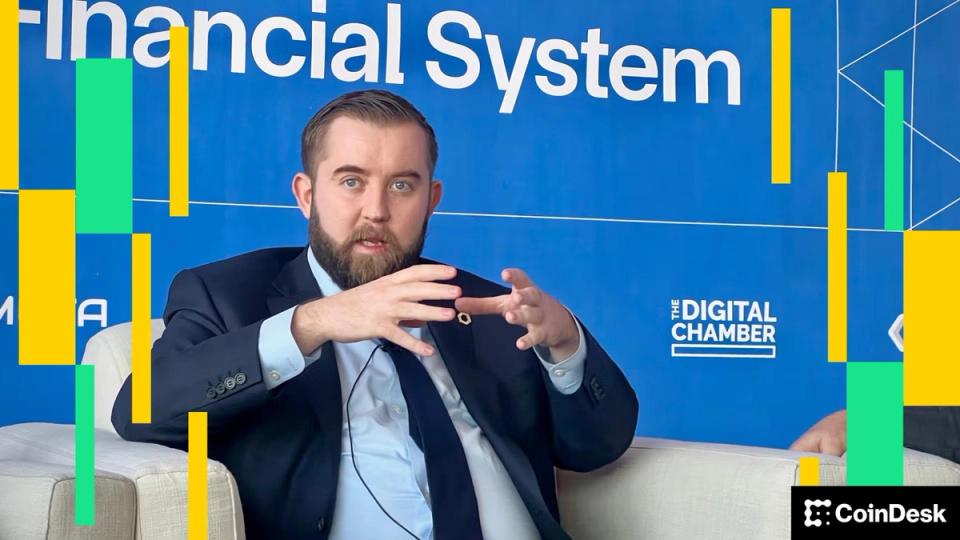In January, the U.S. Energy Information Administration announced that as part of an emergency data collection request, it would require bitcoin mining facilities such as Core Scientific in Denton and Riot Platforms in Rockdale to record their energy use for the first time through a preliminary survey report. called the Cryptocurrency Mining Facilities Report.
Riot Platforms, the nation’s largest bitcoin miner, and the Texas Blockchain Council, an industry advocate for cryptocurrency mining companies, responded on February 22 with a lawsuit seeking a temporary restraining order to stop the disclosure of their energy usage because they said it would cause irreparable damage. them to disclose proprietary information that the EIA did not have the legal authority to collect.
“This is a case about shoddy government process, salacious and self-inflicted urgency, and intrusive government data collection,” their lawsuit claims.
In response to the litigation, the Energy Information Administration decided on February 23rd to use its discretion and impose no requirement to respond to the survey until March 22nd. That same day, the federal court in Waco entered a temporary restraining order preventing the EIA from collecting data, according to the EIA’s letter Monday to the Office of Management and Budget, which approved the emergency data collection in late January.
District Judge Alan Albright on Tuesday afternoon canceled a preliminary injunction hearing set for Wednesday in the Western District of Texas as an “agreement in principle” was reached between the parties that halted the EIA’s emergency data collection, according to court documents.
“We are pleased that the Court has granted the requested TRO and that the EIA has now agreed to stop the ’emergency survey’,” says attorney Chris Davis of the Gray Reed law firm. “It is unfortunate that our clients had to take legal action to get the federal government to simply follow the law, but we are grateful for the court’s thoughtful analysis that led to this result.”
EIA Administrator Joseph DeCarolis said in a letter Monday that the agency intends to continue a process it has already begun under the notice-and-comment procedure of the Paperwork Reduction Act or the Office of Management and Budget must be requested for data collection of the type described in the collection of emergency data.
“If EIA decides to proceed with the proposal of an information collection that data from [that] type, … EIA will publish a notice in the Federal Register detailing the proposed information collection. … This will trigger a public comment period of at least 30 days, after which the Director of OMB can make a decision whether or not to approve the information collection,” DeCarolis’ letter reads.
The process could take up to a year to complete, according to Thomas Cmar, a senior attorney for Earthjustice, a nonprofit environmental law organization. Cmar said the February 22 lawsuit by the Texas Blockchain Council and Riot Platforms “was about the timing and the process the government followed to conduct a survey.”
“The EIA collects this type of information from every energy user in the US, so there’s no question that they have the authority to collect this information,” Cmar said. “It’s just a question of whether this industry is willing to cooperate by making this information publicly available to the extent that it should be publicly available.”
In an email Wednesday, Lee Bratcher, president and founder of the Texas Blockchain Council, shared data from the Electric Reliability Council of Texas that shows what he called “how useful bitcoin miners are when power demand increases.”
Bratcher said bitcoin miners in Texas make up more than 95% of what ERCOT calls “large flexible loads.”
“There are approximately 2,450 [megawatts] of bitcoin mining in Texas, but this load does not contribute to peak demand since, as the data shows, miners curtail their consumption during peak demand,” Bratcher said in his email.
During those times of restrictive consumption, bitcoin miners like Riot Platforms can sell their pre-purchased power back to the network for millions. As The Texas Tribune reported in January, Riot earned $32 million by reducing its energy use last August.
Cmar called it a loophole in Texas law and another reason — along with a lack of regulations — that crypto miners are coming to Texas.
“More and more, the price Texans will pay for power will be controlled by the big bitcoin mining facilities [due to] the massive percentage they use of the grid,” Cmar said.
Texas has been called a bitcoin boom state with nearly 30 crypto mining facilities, including Core Scientific in Denton and another unnamed one on the way after the Denton City Council last week ordered staff to move forward with the project.
“These crypto-mining facilities stress electrical grids, threaten to increase electric bills wherever they operate, and increase emissions from fossil-burning power plants that pollute our air and water and contribute to climate change,” Cmar said in a statement Tuesday. Blockchain Council and Riot Platforms’ Lawsuit.
Last summer, ERCOT reported that it saw an unprecedented amount of larger loads — more demand — interconnected and could not identify the larger load facilities — bitcoin miners — tapping into the network.
They also experienced a significant amount of large loads unexpectedly disconnecting from the grid and inconsistent behavior of large loads during resource-scarce events, according to an Aug. 16 ERCOT presentation.
The EIA is primarily a research organization that takes data from energy users and produces reports. Those reports show how much energy different industries use, where it comes from and how much they pay for it. It’s a well-established process, year after year, that Cmar said state regulators across the country rely on to do their energy planning.
Through the EIA that started the emergency data collection, Cmar said, they were trying to “level the playing field” by requiring crypto mining companies to start reporting their energy consumption.
“The lawsuit in Waco seems to be trying to push it as long as possible,” Cmar said.
Core Scientific already reports its use to Denton Municipal Electric — and so will the new smaller crypto-mining facility, once operational at the airport industrial park — because it buys electricity. But Stuart Birdseye, a DME spokesman, said the mine’s use would remain a mystery to the public.
“According to Texas law, DME is not permitted to discuss the actual customer’s energy usage or their bills,” Birdseye wrote in a Sept. 28 email to the Denton Record-Chronicle. “However, when the Core Scientific project was discussed with the Denton City Council in late 2021, DME provided estimates of their power consumption and the associated revenue that the City of Denton could realize when the project is fully developed.
“This is estimated to double the overall City of Denton’s annual energy use when the project is fully developed, but will not affect the energy used by other DME customers.”
In a Feb. 22 email, Mayor Pro Tem Brian Beck said facilities consuming power from DME’s 100% renewable energy market are different from using Oncor or Reliant Energy, which he said uses a 69% ERCOT energy mix fossil fuels up to 31% use renewable energy.
“Because DME only obtains power and power credits from wind and solar sources, we’re actually promoting more renewable energy in Texas and reducing the carbon produced relative to whether it’s located in Flower Mound or Decatur,” Beck said.
On Sunday, more than 80% of electricity on the Texas grid came from wind and solar—a new record for ERCOT.
Denton councilors also created what Beck called a new zoning class for mining data centers, including requirements that set noise limits at “about the same sound level as having a loud conversation.”
But Cmar said you have to look at the entire impact on the network and the stress caused by running computer-filled data centers 24/7 to mine bitcoin, which on Wednesday peaked for the first time since November 2021 at a price of $63,000.
The US Department of Energy found that the electricity used to mine cryptocurrencies is roughly equivalent to all the electricity used by homes in Colorado or California, depending on usage, and “likely higher in Texas,” according to a report by February 28 by Texas Monthly.
In September, Earthjustice reported that Texas’ top five bitcoin miners used a total of 1,212 megawatts in one day, which is as much energy as 242,400 Texas homes. Those top five miners beat Riot Platforms in Rockdale at 450 megawatts at no. 1 included, followed by Cipher Mining in Odessa at 207 megawatts and US Bitcoin in Upton County at 200 megawatts.
Core Scientific in Denton could take the No. 2 spot once it reaches full capacity. Core Scientific CEO Adam Sullivan told the Record-Chronicle that the Denton facility is expected to reach 297 megawatts at full capacity.
In a Feb. 20 presentation to the city council, DME claimed that both the city and the electric utility stand to make millions from the deal with the new bitcoin miner.
Beck pointed out that 17% to 33% of data center revenue is allocated directly to the city’s sustainability fund, one that Beck says now more than doubles rebates for energy-reducing technologies such as electric vehicles, e-bikes, new energy-efficient appliances and smart thermostats.
“We are in no way incentivizing crypto mining,” Beck wrote in his February 22 email. “We don’t give them grants or cheaper rates or invest in their companies. We only sell renewable power to them. And we demand through our contracts that when there are periods of low reserves, they switch off and thus make more electricity available to hospitals and residents.”
Denton’s new crypto deal comes at a time when crypto miners in Texas may have already raised electricity costs for Texans by $1.8 billion a year, based on calculations of the “blue sky” hours (when prices are low) by Wood Mackenzie, a global data and analytics business.
“Bitcoin mining is likely to have stronger impacts on the network over time as the number of larger and more power-hungry mining facilities is likely to grow,” Wood Mackenzie said in its September 27 report.
Bratcher, of the Texas Blockchain Council, disagreed with Wood Mackenzie’s estimates, saying they are inaccurate because they “don’t factor in the downward price pressure that miners have because we’re shorting during peak price times.
“They also don’t consider how bitcoin miners lower the price ERCOT pays to obtain demand response services.”
Disclaimer for Uncirculars, with a Touch of Personality:
While we love diving into the exciting world of crypto here at Uncirculars, remember that this post, and all our content, is purely for your information and exploration. Think of it as your crypto compass, pointing you in the right direction to do your own research and make informed decisions.
No legal, tax, investment, or financial advice should be inferred from these pixels. We’re not fortune tellers or stockbrokers, just passionate crypto enthusiasts sharing our knowledge.
And just like that rollercoaster ride in your favorite DeFi protocol, past performance isn’t a guarantee of future thrills. The value of crypto assets can be as unpredictable as a moon landing, so buckle up and do your due diligence before taking the plunge.
Ultimately, any crypto adventure you embark on is yours alone. We’re just happy to be your crypto companion, cheering you on from the sidelines (and maybe sharing some snacks along the way). So research, explore, and remember, with a little knowledge and a lot of curiosity, you can navigate the crypto cosmos like a pro!
UnCirculars – Cutting through the noise, delivering unbiased crypto news







